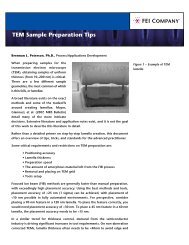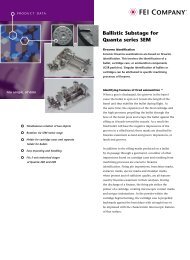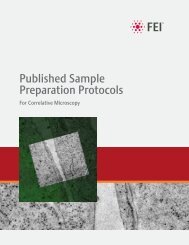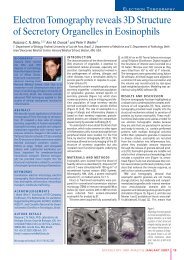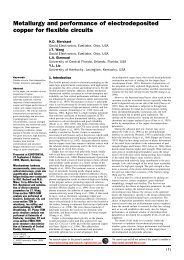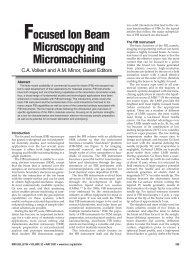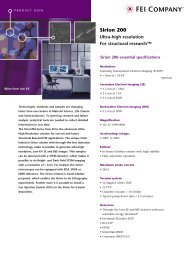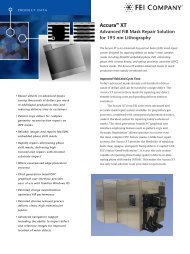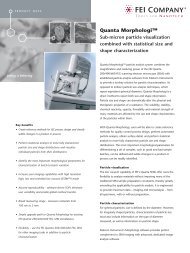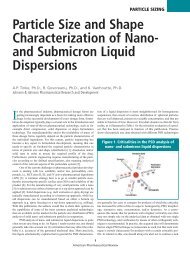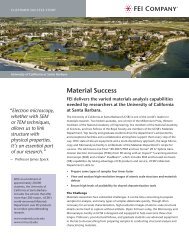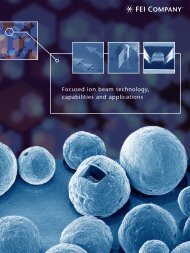Wet STEM: A newdevelopment in environmental SEM for imaging ...
Wet STEM: A newdevelopment in environmental SEM for imaging ...
Wet STEM: A newdevelopment in environmental SEM for imaging ...
Create successful ePaper yourself
Turn your PDF publications into a flip-book with our unique Google optimized e-Paper software.
292<br />
cyl<strong>in</strong>drical <strong>SEM</strong> mount, and positioned on the<br />
Peltier stage. A droplet of liquid conta<strong>in</strong><strong>in</strong>g<br />
particles or float<strong>in</strong>g objects (organic, <strong>in</strong>organic,<br />
liquid or solid) is droped on the grid with an<br />
eppendorf s micropipette. In these conditions, the<br />
<strong>in</strong>cident electron beam passes through the droplet,<br />
i.e. the liquid layer and a given amount of float<strong>in</strong>g<br />
particles. The signal is then collected by a detector,<br />
usually used <strong>for</strong> the collection of backscattered<br />
electrons (BSE), but <strong>in</strong> our case located belowthe<br />
sample. We used holey carbon coated TEM<br />
copper grids, with the carbon layer down <strong>in</strong> order<br />
to use copper squares as retention bas<strong>in</strong>s. In the<br />
carbon layer, holes of typical diameter rang<strong>in</strong>g<br />
from less than 1 to 20 mm allowma<strong>in</strong>ta<strong>in</strong><strong>in</strong>g<br />
overhang<strong>in</strong>g liquid films on very small areas. It is<br />
important to note that adequate <strong>in</strong>itial droplet<br />
parameters—i.e. volume and solid content—enable<br />
to control the amount of particles on the grid.<br />
It is possible, <strong>for</strong> <strong>in</strong>stance <strong>in</strong> the case of a latex<br />
emulsion sample, to choose to image only a<br />
monolayer of particles if required.<br />
Due to the <strong>in</strong>itial concentration of the suspension,<br />
when the droplet of smallest volume that can<br />
be droped conta<strong>in</strong>s more objects than <strong>for</strong> a<br />
monolayer on the grid, a dilution step with<br />
distilled water can be per<strong>for</strong>med.<br />
Classical E<strong>SEM</strong> detectors also available enable<br />
the control of the sample surface <strong>in</strong> SE mode and<br />
<strong>in</strong> BSE mode, us<strong>in</strong>g the gaseous SE detector<br />
GSED, and the gaseous backscattered electron<br />
detector GAD, respectively. This is very helpful<br />
<strong>for</strong> example to control the presence of liquid until<br />
the thickness is adequate to per<strong>for</strong>m transmission<br />
observations and to detect if objects are not<br />
submerged <strong>in</strong> water anymore.<br />
2.2. Purge sequence<br />
In relation with the work described <strong>in</strong> Ref. [4],<br />
an optimized pump down sequence is used <strong>in</strong> order<br />
to prevent evaporation from, and condensation on<br />
the sample droplet. Parameters like water source<br />
bottle temperature, sample temperature, <strong>in</strong>itial<br />
relative humidity rate <strong>in</strong> the microscope chamber,<br />
number of pump<strong>in</strong>g and flood<strong>in</strong>g cycles, upper<br />
and lower pressures <strong>for</strong> the purge are carefully<br />
controlled dur<strong>in</strong>g the sequence.<br />
ARTICLE IN PRESS<br />
A. Bogner et al. / Ultramicroscopy 104 (2005) 290–301<br />
2.3. Imag<strong>in</strong>g sequence<br />
The pressure and temperature can be adjusted to<br />
evaporate a small amount of water from the<br />
droplet. It allows to keep a water layer th<strong>in</strong> enough<br />
so that electrons both transmitted and scattered<br />
pass through it, and can be collected to participate<br />
to the <strong>for</strong>mation of a <strong>STEM</strong> image. Th<strong>in</strong> films of<br />
wet samples are created <strong>in</strong> situ <strong>in</strong> the E<strong>SEM</strong><br />
chamber, their thickness depend<strong>in</strong>g on the quantity<br />
of water evaporated from the <strong>in</strong>itial droplet.<br />
The solid content of the sample is controlled so<br />
that the <strong>in</strong>itial solid content and the <strong>in</strong>itial droplet<br />
volume are known. As evaporation is an endothermic<br />
reaction, it is then possible to followit<br />
by check<strong>in</strong>g the difference between the sett<strong>in</strong>g<br />
temperature and the measured one. Then the<br />
thickness of the film is kept constant thanks to<br />
an equilibrium water pressure us<strong>in</strong>g the (P,T)<br />
water diagram [5]. For <strong>in</strong>stance, a water pressure<br />
of 5.3 torr is required at a sample temperature of<br />
2 1C, so that objects rema<strong>in</strong> <strong>in</strong> a constant water<br />
layer. By controll<strong>in</strong>g the sample temperature<br />
through the Peltier stage, and us<strong>in</strong>g water vapour<br />
as the imag<strong>in</strong>g gas at a controlled pressure,<br />
samples can be kept above their saturated vapour<br />
pressure dur<strong>in</strong>g all the experiment.<br />
2.4. Imag<strong>in</strong>g mode<br />
In <strong>SEM</strong>, the detection strategy <strong>in</strong> <strong>STEM</strong> mode<br />
is based on the direct collection of electrons<br />
pass<strong>in</strong>g through the sample, by a solid-state<br />
detector (two semi-annular detectors A and B).<br />
For the configuration usually used, the <strong>in</strong>cident<br />
electron beam arrives on the limit of diodes A and<br />
B, and bright- or dark-field images can be<br />
produced with the collection of transmitted or<br />
scattered electrons, respectively. In this case, only<br />
a small area of the sample is above the limit of A<br />
and B. In the present study, we choose another<br />
possibility: annular dark-field imag<strong>in</strong>g conditions<br />
can be obta<strong>in</strong>ed if the dipolar detector is placed so<br />
that it occults the transmitted electron beam and it<br />
only collects scattered beams on a r<strong>in</strong>g constituted<br />
by both diodes A and B. Us<strong>in</strong>g this method, a<br />
more important part of the scattered electrons<br />
available is used to <strong>for</strong>m an image and more



